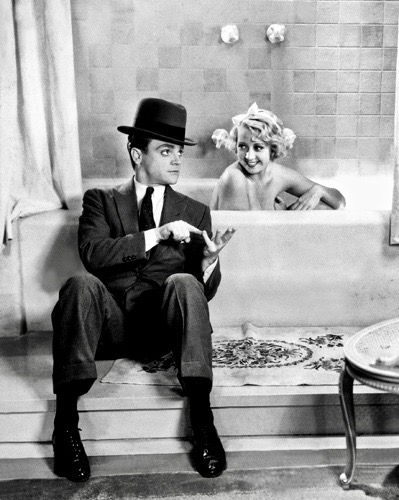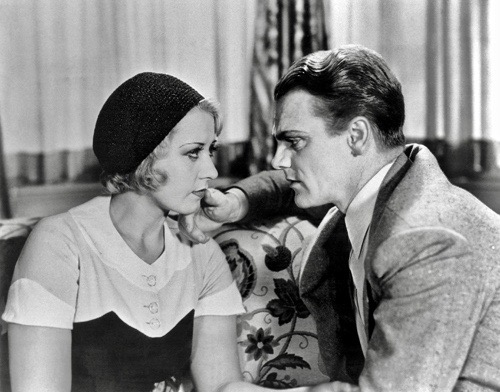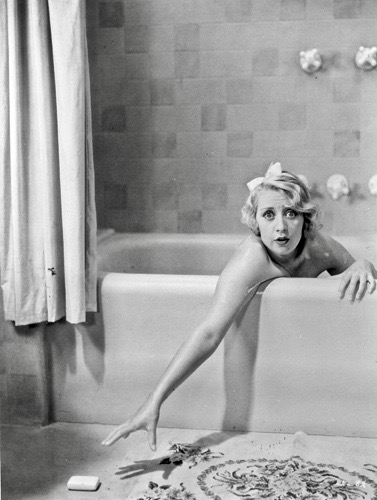 Could there have been a more ideally matched couple from the Warner Bros. stock company than this pair of New York natives with their street-smart ways and attitudes to match? It seems strange that James Cagney and Joan Blondell aren’t usually included in that rarified group of Gable & Harlow or Tracy & Hepburn or Bogart & Bacall or Loy & Powell and others but Blonde Crazy (1931) alone is reason enough to add this duo to the Hollywood leading couples A-list.
Could there have been a more ideally matched couple from the Warner Bros. stock company than this pair of New York natives with their street-smart ways and attitudes to match? It seems strange that James Cagney and Joan Blondell aren’t usually included in that rarified group of Gable & Harlow or Tracy & Hepburn or Bogart & Bacall or Loy & Powell and others but Blonde Crazy (1931) alone is reason enough to add this duo to the Hollywood leading couples A-list.

Joan Blondell & James Cagney made seven films together and were romantically paired in four of them.
First a little background. In all, Blondell and Cagney made seven films together and in four of them they were paired romantically – Sinner’s Holiday (1930), Blonde Crazy (1931), Footlight Parade (1933) and He Was Her Man (1934). In their first pairing, Sinner’s Holiday, we get to see the snap, crackle and pop between them at an embryonic stage in their movie careers. Joan plays a carnie who falls for a fellow sideshow co-worker (Cagney) with a bootleg operation on the sly. They are not the main focus of the story and merely serve as a subplot with limited screen time together but the chemistry between them is already obvious.

Joan Blondell and James Cagney appear in their first film together, Sinners’ Holiday (1930) but they are not the stars; they are in supporting roles.
One reason they appear so spontaneous and natural together is because they are playing the same roles they played in the stage version of Sinner’s Holiday which was entitled Penny Arcade (written by Marie Baumer). Offscreen the two actors were good friends and first met at auditions for the stage production of Maggie the Magnificent in 1929. Blondell recalls her first meeting of Cagney at the audition when he said to her, “Your eyes are so big they look like they’re about to pop out of your head.”
The actor always had great affection for Blondell (they remained lifelong friends) and had several nicknames for her as well such as “the naïve sophisticate” and “Grandma.” According to Cagney’s biographer John McCabe he also described Blondell “as having the most beautiful ass in Christendom” which most male viewers can attest to in movies such as Gold Diggers of 1933 and Night Nurse (1931).

Barbara Stanwyck (left) and Joan Blondell are roommates in the classic Pre-Code melodrama, Night Nurse (1931), directed by William A. Wellman.
In his autobiography, Cagney by Cagney, the actor is a little less explicit in his assessment of Joan’s appeal when they first met in Maggie the Magnificent: “I played a young heel, and Joan was the character comedienne, all gum-chewing and wisecracks and sidelong glances. I also must say I noted at the time that she had a perfectly beautiful body – something my bride knows I’ve said a number of times.”

James Cagney (left), Joan Blondell and Edward Woods appear in a publicity photo for The Public Enemy (1931).
In their next two films together, William Wellman’s Other Men’s Women (1931) and The Public Enemy (1931), Joan and Jimmy only share one scene together in the former (where they appear with different dance partners in a hotel ballroom). In the latter gangster drama, Blondell has a minor role as the wife of Matt Doyle (Edward Woods), who is the title character’s best friend. It wasn’t until their fourth film, Blonde Crazy, that the two actors were front and center as the leading couple and top billed together on the marquee. 
They are a potent, sizzling combo in this down and dirty tale of two grifters (one unrepentant, the other reluctant) and it should have elevated them to the top tier of beloved screen couples but it didn’t…possibly because the film, directed by Roy Del Ruth, was seen at the time as a standard studio programmer and no more than that despite its merits. Instead Warner Bros. rushed them into other productions without taking any time to nurture and develop Blondell & Cagney as a screen team (this was long before post-screening marketing surveys). 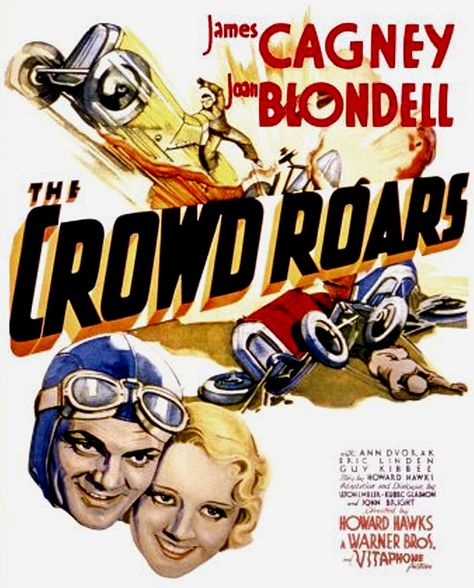
Their next assignment together was Howard Hawks’s The Crowd Roars (1932) but they weren’t paired romantically in this one either. Blondell plays the practical, wisecracking best friend of Ann Dvorak who tries to discourage her from wasting her time on Cagney’s inattentive race car driver. In an unforeseen twist, Blondell ends up falling in love with Cagney’s competitive younger brother Eddie (Eric Linden) and further aggravates a riff between them, incurring Jimmy’s wrath – their confrontation scene is one of the strongest in the picture but for the most part Blondell is relegated to the sidelines here. 
It’s true that Joan and Jimmy were eventually teamed again romantically in Footlight Parade (1933) and He Was Her Man (1934) but in the former picture she is reduced to playing his faithful, loving but mostly ignored secretary until the climax when she is responsible for his big success and he rewards her with a marriage proposal and brief peck on the lips. 
He Was Her Man is a surprisingly downbeat slice-of-life character study that qualifies as a tragedy in its story of a former prostitute engaged to marry an immigrant fisherman (Victor Jory) and the two-bit gangster (Cagney with an unbecoming moustache) who comes into her life and almost wrecks her last shot at happiness. While immensely enjoyable in their own ways, neither of these films exploit the lively dynamic between Blondell and Cagney as well as Blonde Crazy.
In Blonde Crazy, they are best friends, professional partners and in love with each other though Cagney doesn’t acknowledge this until too late in the game. As an alternative to the elegant, droll and sophisticated comedy team of William Powell and Myrna Loy, James Cagney and Joan Blondell are the tough, proletariat and street-smart flip side of a romantic leading couple by Hollywood standards. And while Powell and Loy might have been the idealized fantasy screen couple of the Depression era, Cagney and Blondell were much closer to the average moviegoer’s idea of an urban working class couple.
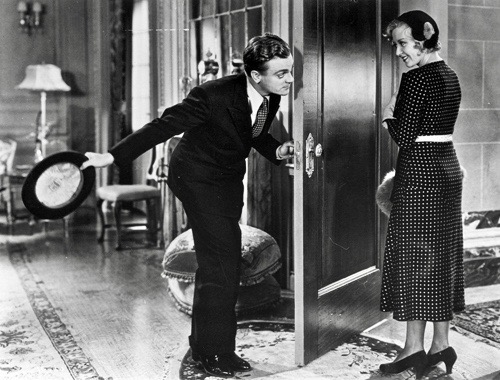
James Cagney and Joan Blondell play hotel employees who team up as con-artists in Blonde Crazy (1931), directed by Roy Del Ruth.
In addition to being one of the best Pre-Code features from Warner Bros., the movie is glorious confirmation that this feisty duo were equal sparring partners in the battle of the sexes and deserved many more co-starring opportunities which gave them equal screen time together. 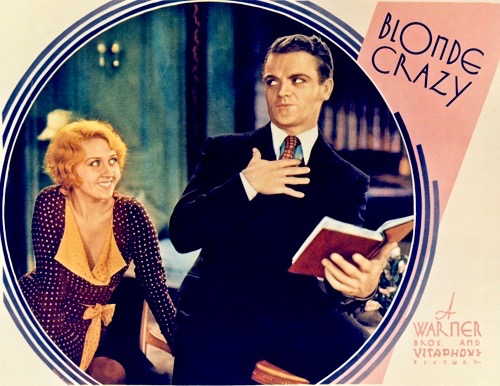
After a credit sequence where the camera pulls back from a crooner with a megaphone to reveal a hotel ballroom, Blonde Crazy introduces us to Cagney as Bertie Harris, a hustling bellhop at “The Leading Hotel of a small Mid Western City” (according to the wry, tongue-in-cheek screen caption). And Blondell is Anne Roberts, an unemployed single girl who gets hired as a chambermaid thanks to Bert’s gift for manipulation. Soon they’re off and running in a fast paced plot that takes them to “The Leading Hotel of a Big City” (Chicago) and “The Leading Hotel in the Largest City” (New York) and along the way we share in their lightly played misadventures among the hustlers, con-artists and shysters they sometimes partner with, sometimes are cheated by and sometimes take revenge on.
Through it all Annie remains the loyal, sensible and surprisingly virtuous one (considering the circumstances), while Bert continues to spin ever larger get-rich-quick schemes that eventually blow up in his face. The final act finds Bert chastened by his experience but willing to perform one last illegal act as a favor to Anne who has since married an upper class businessman (Ray Milland in an early role) who has embezzled money from his company that he lost in the stock market.

Ray Milland, in one of his earliest Hollywood roles, plays an embezzler married to Joan Blondell in Blonde Crazy (1931).
The twist ending of Blonde Crazy delivers sweet redemption and even a closing joke of resilient optimism in the place of how the usual Warner Bros. crime drama plays out. It is also one of the few times Cagney allows himself to be tender and romantic on screen, kissing Blondell full on the lips (though partly obscured by the camera angle) and then grabbing her hand and caressing and kissing it longingly.
At the time of Blonde Crazy’s release, which was several months after the release of The Public Enemy, Cagney’s on-screen persona was already well established and so was his aggressive physical nature toward not just men but women. His habit of slapping his co-stars gets turned on its head in Blonde Crazy as Blondell gives him the same treatment without losing any of her femininity or sexiness in the process. In fact, Blondell’s responding slaps to Cagney’s wisecracks in this film serve as a sort of foreplay for the couple as evidenced by this scene after Anne’s has smacked his face again for impertinence:
Bert: “You know you’re the first girl who’s ever slapped me for going for her…you know honey, I’d like you to sock me like that every day.”
Anne: “Oh really?”
Bert: Oh yeah, HONE-EE. I’d love it.”
Anne wallops him again and leaves while Bert laughs and says gleefully, “What a woman!” There may be more slapping scenes in Blonde Crazy (most of them with Blondell as the initiator) than in any other Cagney film which is saying something.
Blondell had been typecast for most of her career at Warner Bros. as a blue collar heroine who played her share of chorines, waitresses, nurses, factory or office girls. She was not the sort of actress to get cast as a sophisticated heiress in a screwball comedy like My Man Godfrey or a social satire like Platinum Blonde though if she had been cast in those parts, she could have undoubtedly pulled them off in style. According to Cagney, playwright George Kelly (The Show-off, Craig’s Wife) told the actor that if Blondell “hadn’t looked like a tootsie, she’d have made a great Lady Macbeth. He called her the ‘undiscovered country,’ and I think he was right.”
Instead Joan’s appeal was more down to earth and approachable. There was something familiar but still undeniably fresh and appealing about Blondell’s open, direct manner. And with those huge, expressive saucer eyes and that figure she was like a blonde Betty Boop in human form except for the voice…which could sling zingers and quips with the best of ‘em. 
Blondell has acknowledged in various interviews over the years that she didn’t campaign or push for more serious parts though she had no reservations about being able to perform any role offered her. But even at an early stage in her career, she began to understand her screen appeal. “I would get endless fan mail from girls saying ‘That is exactly what I would have done, if I’d been in your shoes, you did exactly the right thing.’So I figured that was my popularity, relating to the girls…They just wanted more of the same thing. All you got were new clothes and new sets, but the stories were pretty much alike and I was the same type. But those early days of talkies were incredible, what with the sound-proof camera booth and everything. I think that’s why they signed Cagney and me so fast, ‘cause we just went through it like we were on stage and they weren’t used to that. We were showing something different, something fast and to the point.” (from Joan Blondell: A Life Between Takes by Matthew Kennedy, University Press of Mississippi). 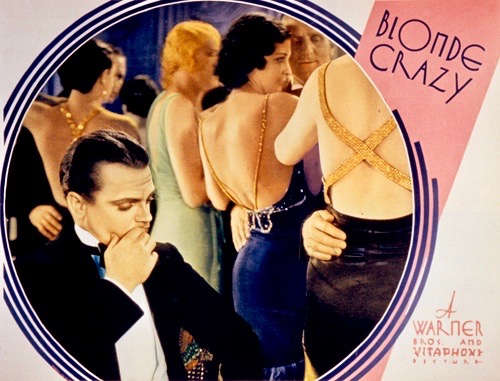
While Blonde Crazy is formulaic in many ways, it’s also loaded with whip-smart funny dialogue. But part of what makes the lines so vivid and sparkling is not the screenwriter’s wit as much as Blondell and Cagney’s delivery and inflection. There is a brief scene where Anne tries to hide her anger and disgust at being ignored all evening by Bert at a club while he flirts with another blonde (Noel Francis). As she bids him goodnight, Anne says in a flat robotic voice with a hint of sarcasm, “I’ve had a very pleasant evening,” while shooting him a stare that would shake the confidence of a lesser man. A better example of her sizing up the moment and following her better instincts is a scene where a hotel guest (Guy Kibbee) tries to get fresh with her during room service.
Anne: Shall I do your bed?
Mr. Johnson: Kinda early, isn’t it?
Anne: Not if you’re going to bed.
Mr. Johnson: Well a bed doesn’t mean much to a fellow like me. Just a place to rest my head.
Anne: What a treat for the bed!
Mr. Johnson: Say, what about a little nip together? Just you and me?
Anne (her voice suddenly becoming coy and playful): Why just you and me? What about your other friend, the little fellow over there in the green sweater?
And Anne quickly sprints out of the room as a confused Mr. Johnson looks behind him.

James Cagney (left) and Guy Kibbee star in the delightful Warner Bros. Pre-Code comedy Blonde Crazy (1931), directed by Roy De Ruth.
The telltale signs of a Pre-Code film are everywhere in Blonde Crazy. There is the casual nudity of Anne in the bathtub as Bert toys with her brassiere in the other room looking for a hidden stash of money. Or the way Bert sizes up the assets of every woman he meets by giving their backsides a good up and down. In one choice scene he makes fun of a book of poetry by Robert Browning that Anne’s rich suitor has given her. Adopting an effete, sissified manner, he reads a few lines of the poetry and then dismisses it with “He may be a poet to you but he’s a peasant to me.”
There is also a welcome absence of moralizing evident throughout when you consider that the protagonists are little more than petty criminals. Anne may voice her concerns about what they are doing but the con games continue and the duo are clearly the most appealing and charismatic characters in the film.
What is most interesting of all but is rarely depicted in Anne and Bert’s various grifter activities is Anne’s role in the schemes (except in one scene where Guy Kibbee is caught with Blondell by a phony cop in a compromising situation). We do see her act as a lure for Dapper Dan Barker (Louis Calhern), who previously outfoxed Bert in a counterfeit bill scheme, and mastermind a sting of her own but we have to read between the lines on what she does with Dan before hoodwinking him. All we get from her is this comment to Bert, “Well, thanks heavens that’s over with. You have no idea how hard it is to put up with getting pawed by someone you don’t care for.”
Upon release, Blonde Crazy wasn’t treated any differently by the critics and reviewers of its day than any other Warner Bros. programmer though many appeared to enjoy it. Variety described it as “Wise remarks, a fresh guy and dame stuff. Quick pace and a performance by James Cagney typically Cagney. These give Blonde Crazy a fast start and keep it going most of the way…Joan Blondell is Cagney’s business partner – and what a business – who loves him in other ways besides biz but doesn’t find that out until her marriage to a comparative nice boy proves a flop. Everything depends on the dialog and playing – both come through satisfactorily. Cagney and Blondell make a natural pair.”

Blonde Crazy (1931)
Directed by Roy Del Ruth
Shown from left: Charles Lane, Joan Blondell, James Cagney
Mordaunt Hall in the December 4, 1931 New York Times wrote, “Unedifying though the incidents are and feeble as is the attempt at a moral, the greater part of James Cagney’s new picture, Blonde Crazy, which took possession of the Warners’ Strand screen last night, is lively and cleverly acted…Mr. Cagney is as alert and pugnacious as Bert Harris as he was as the quick-thinking young gangster of The Public Enemy...Miss Blondell gives an efficient portrayal. Mr. Calhern is equal to the demands of his part. Guy Kibbee furnishes some laughs as one of Harris’s victims. Noel Francis gives a satisfactory performance as Helen, the blonde to whom Dapper Dan is partial for a time.” And Time magazine called it “a chipper, hard-boiled amusing essay in petty thieving.” 
Blonde Crazy was finally made available on DVD in November 2014 as part of the Warner Archive Forbidden Hollywood Collection Volume 8 which also included Strangers May Kiss, Hi, Nellie and Dark Hazard. It is not available as a solo disc but the Forbidden Hollywood Collection is worth owning for this title alone. Blonde Crazy also pops up occasionally on Turner Classic Movies.
Other websites of interest:
https://news.warnerarchive.com/all-about-joan-blondell-12878ac6a68d
https://dreaminginthebalcony.wordpress.com/2017/08/30/joan-blondell-a-life-between-takes/
https://www.slantmagazine.com/film/joan-blondell-working-girl/
https://twentyfourframes.wordpress.com/2013/04/09/the-films-of-james-cagney-and-joan-blondell/
https://www.thefamouspeople.com/profiles/james-cagney-5461.php
https://www.britannica.com/biography/Roy-Del-Ruth
www.moviediva.com/MD_root/reviewpages/MDBlondeCrazy.htm
https://www.youtube.com/watch?v=4peX8gRYFb4


